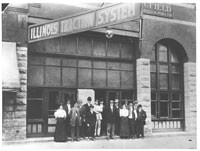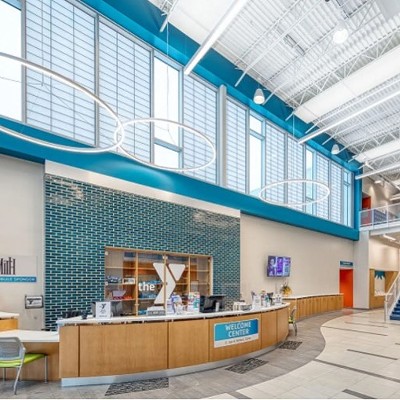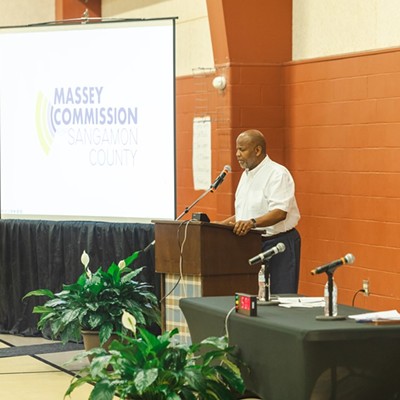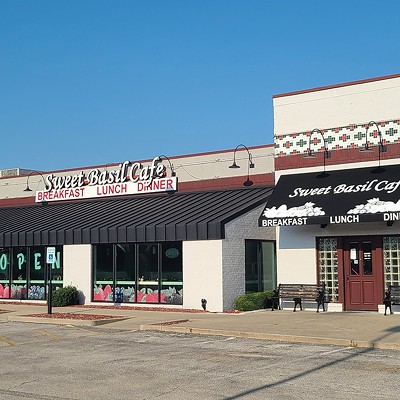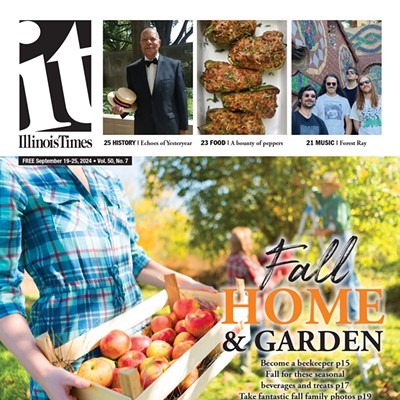"The interurban was an American transportation phenomenon. Evolved from the urban streetcar, the interurban appeared shortly before the dawn of the 20th century, grew to a vast network of over 18,000 miles in two decades of excellent growth, and then but vanished after barely three decades of usefulness." -- William D. Middleton, The Interurban Era (1961)
It's a beautiful fall day, and I'm traveling down Old Route 36 on my months-long quest to document the remains of the old Interurban, the electric railroad system that used to knit central and southern Illinois communities together.
Today's goal: Find the Buffalo station.
As I reach the center of town, an old tan brick building is in plain sight along the north side of the road. The round wall electric bushings, protruding from the building, are a dead giveaway -- I've found it. Built in 1906, the structure's still in good condition, even after all these years of harsh Illinois weather beating down on it.
I stop to take a few photographs, then a pickup rolls up. What are you doing, a nice elderly couple inquires politely. I explain that I'm doing research on the Interurban. Immediately, their faces brighten.
Donald and Ester Kirby bought the station about 20 years ago to store their farm machinery. But, as is the case with many other older Illinoisans, their connection to the station goes back much further.
Back in the heyday of the Interurban, the Kirbys were frequent passengers. In the 1940s, Donald says he'd hop the train at the very station he now owns and ride to Springfield to catch a motion picture at the Senate or Strand theaters. "We'd walk to the theater from the train station and take the midnight train back home," he recalls. Esther used to take the Interurban to Illiopolis and Springfield to go shopping.
In 1945, Donald Kirby and his high school team won the county basketball tournament and were rewarded with an Interurban trip to Champaign to see the state tournament.
"I loved riding on the Interurban," Kirby says.
Illinois once was and still is the rail hub of the nation. In 1920, it had more than 12,000 miles of railroad tracks, but by the end of the century, that had declined by 40 percent, as tracks were abandoned and railroads merged. Among the companies that successfully transported both goods and people around the state for over a half century was the Illinois Terminal Railroad Company (ITC), which was also known as the Illinois Traction System (ITS) or simply, the Interurban.
The success of the Interurban in central and southern Illinois can be traced to one individual, William B. McKinley. Born in Petersburg, McKinley settled in Champaign and became a leading businessman and politician. In the late 19th century, McKinley acquired the Urbana & Railway Street Gas and Electric Co. That purchase led to the launch of the Interurban system.
The Interurban consisted of a series of subsidiary companies controlled by McKinley. His holdings included the St. Louis and Springfield Railroad, Illinois Traction, and the Peoria, Bloomington & Champaign Traction. According to Dale Jenkins, president of the Illinois Traction Society, an organization established to preserve the history of the Illinois Terminal and subsidiaries, McKinley set up a number of subsidiaries to ensure the entire system wasn't affected if one of the lines failed financially. The name Illinois Terminal was formally incorporated in 1937.
The Interurban was an electrified railroad with tracks laid down the center of the streets that it served. One to three passenger cars and an occasional freight car snaked their way through various central Illinois downtown locations before making their way to the outskirts of town. Train motormen had to keep a close eye out for pedestrians, vehicles, and even a stray goat or two. Conductors frequently would have to disembark to lead the train through a city intersection. In the country, the Interurban traveled past cornfields, paralleling roads and other railroad lines.
A trolley wire, suspended by guide wires from poles, was laid out in the cities and lined the linear tracks through the countryside. Substations to convert alternating current to direct current were built along the track or within passenger stations.
The ITC was dominant throughout central and southern Illinois, linking towns like Danville, Champaign, Decatur, Bloomington, Peoria, Lincoln, Springfield, Carlinville, Staunton, and Edwardsville. In 1910, the system was tied to St. Louis with the completion of the majestic McKinley Bridge across the Mississippi. At its peak, the ITC had over 550 miles of tracks, Jenkins says.
Julie Jeffers of Riverton grew up in south Bloomington, and as a child rode on the Interurban numerous times. "As a child my parents put me on the Interurban so I could visit my grandparents in Heyworth," Jeffers recalls. "The train conductor made sure that I arrived safely there as my grandfather waited for me at the train station." Jeffers grew up on Miller Street just a half block from the main Interurban route down Madison Street. "Interurban cars used to go by all the time," she says.
Today, driving down Madison Street north of Lincoln Street, you'll get a feel for the Interurban traveling down this narrow tree-lined street. At Oakland and Madison, the Interurban rail lines are visible in the street center. Past Mill Street and the active railroad line, on the west side of Madison, you'll see an Interurban station.
When she was older, Jeffers says she and her girlfriends would hop the Interurban in the morning "and travel to Peoria to shop at Bergner's and other downtown stores. After a day of shopping, we headed back in the afternoon."
Although there were stations in the communities along the Interurban line, passengers could also wave down an Interurban to catch their ride, Jeffers recalls.
Here in Springfield, the early Interurban track came north from Chatham, crossed Wabash Avenue and the Wabash Railroad tracks, paralleled Holmes Avenue, then turned east on Laurel Street, north onto Spring Street, passing the west side of the Capital, and finally heading east down Monroe Street to the train station. Today, a short corridor is still seen south of Laurel, between Holmes and Walnut.
Jenkins says Springfield had four different railroad depots during the Interurban's history: 520 E. Monroe St., 801 E. Monroe St., the entire north side of the 800 block of East Monroe, and finally at 2015 Clear Lake Ave. Today, the depot at 801 Monroe is the location of Saputo's Restaurant; until recently, the passenger/freight station on Clear Lake was the home of Henson Robinson Co.
Jenkins grew up a few blocks from the Clear Lake Station and is an excellent resource on the history of the ITS/ITC system. According to The Illinois Traction System, a beautifully illustrated history of the Interurban by George Fehl, the Clear Lake station in Springfield opened on Feb. 23, 1933 and closed in March 3, 1956, when the Interurban ended passenger service.
One of the reasons for the Interurban's early success was the company's ability to adapt. When freight service proved profitable, the company moved some of its lines away for city core areas to avoid traffic and tight turning radiuses. Belt lines were constructed around a few towns, including Champaign, Decatur, Edwardsville, Granite City, and Springfield.
Jenkins says the Springfield belt line opened in 1911, and the line going down Spring Street and Monroe was abandoned in 1934. Most Springfieldians heading south today on Fourth and Fifth streets pass under the old belt line railroad without even knowing it. The belt line headed east and turned northeast crossing Taylor Avenue, then headed north going over Ash Street, Laurel Street, South Grand Avenue, Cook Street, and Clear Lake Avenue, finally tying into the rail yards east of the Clear Lake Station.
I wasn't even born yet when the Interurban stopped carrying passengers. As with all passenger railroads in the mid-'50s, ridership fell victim to the growing popularity of the automobile. A quarter-century later, diesel freight service on the Interurban also would end -- and the system would be dismantled, piece by piece.
Today, the Interurban's legacy continues not as a electric railroad company, but through the landscape, the people who help preserve its history, historical structures that have survived, and multi-purpose trails that have been built along its old corridor.
A great way to appreciate the Interurban is to explore the countryside, looking for remaining landmarks. First, though, I recommend going to the library to view George Fehl's book and locate the U.S. Geological Survey topographic maps for areas you plan to explore. Topographic maps are helpful because abandoned rail corridors are often depicted or a trail is identified. Sometimes, "Illinois Terminal" is even labeled on the map. By comparing the maps to the illustrations in Fehl's book, you're ready to do some exploring.
From Springfield, drive east to Harristown to see the well-preserved 1910 depot/substation complex that today is home to an oak furniture store. Next to the Harristown Depot is Passenger Car 535, an Interurban trailer car built in 1911. Car 535 is not open to the public, but makes a great photo opportunity. Across the street from the depot, the old Interurban corridor is seen heading west through the central Illinois landscape. Heading west toward Springfield, try locating other train stations, rail corridors, and tracks. East of Buffalo, you'll see a small portion of the Interurban train track that wasn't paved over, as well as Donald and Ester Kirby's train station.
Another Interurban station to explore is in Mackinaw. This station, built in 1910 and on the National Register of Historic Places, is beautifully restored and is home to a floral shop, tearoom, and the Mackinaw Historical Museum. The depot was near the crossroads of the Mackinaw junction, where trains would make a stop and then continue east to Bloomington or south to Lincoln. Inside, visitors get a chance to get a feel for the layout of the station, the freight room, and upstairs where the electrical equipment was located.
At the north end of Springfield along Sand Hill Road, travelers can get a glimpse of the old Ridgely Junction Substation. There's no public access, but the station can be seen from the road at the entrance to the landfill.
Although the Interurban toots are long gone, today pedestrians and bicyclists can get on one of a few developed trails that have been opened to the public on a portion of the old Interurban rail corridor. These trails include: East Peoria (River Trail of Illinois); Springfield-Chatham (Interurban Trail); Virden-Thayer (Virden-Thayer bike trail); Bendl-Gillespie (Bendl-Gillespie Trail); and Edwardsville (Madison County Transit Nature Trail).
Recently, a friend and I rode along the Madison County Nature Trail. As the trail made its way past subdivisions and past the campus of Southern Illinois University at Edwardsville, I could imagine being on the Interurban 70 years ago, making my way to St. Louis and stopping in Edwardsville to pick up a family or two. Children must have been as excited as today's teens when they're allowed to drive their parents' car for the first time.
Along the nearly completed Interurban Trail between Springfield and Chatham, an old concrete signal post is seen along the trail, and the partial bridge over Lake Springfield is still in place. According to Fehl, the bridge over Lake Springfield was built in 1940 to replace the old Lick Creek Bridge structure just to the west. Today, Amtrak flies by on a parallel track next to the Interurban Trail.
Fehl walked over 400 miles to capture details of the Interurban routes and his detailed illustrations capture the layout and legacy of McKinley's traction system; the landscape still offers up what's left -- the remaining stations and corridors.
As I explored the Interurban Trail recently, I wished the old rail line still operated. I imagined hearing a toot of the horn off in the distance, and the clatter of the train wheels spinning on the rails.
Sitting in one of the Interurban cars, glancing out over the central Illinois landscape as I made my way to Peoria or St. Louis would have been a delightful way to spend a day.
For more information
To see or ride on an old Interurban car or electric trolley, a visit to a railroad museum is in order.
The largest in the country, Illinois Railway Museum (815-923-4000; www.irm.org), is located in Union, Ill. This museum has 37 Interurban cars, including seven from the Illinois Terminal Railroad. The museum also offers train rides.
The St. Louis Museum of Transportation (314-965-7998; www.museumoftransport.org), has a few Interurban cars to view, and also offers train rides.
The Monticello Railroad Museum in Monticello, Ill. (217-762-9011; www.prairienet.org/mrm) has one Interurban box car and owns a portion of the Interurban corridor next to their active corridor.
The Fox River Trolley Museum (847-697-4676; www.foxtrolley.org) in south Elgin has electric trains and offers a short train ride.
Locally, the beautifully restored Chatham Railroad Museum (217-483-2214; 483-7792) has Interurban photographs and various Interurban railroad memorabilia.
Another resource is the Illinois Traction Society (www.illinoistractionsociety.org). The organization's 2004 calendar, depicting 14 scenes of Interurban railroading, can be ordered by sending $9 postpaid to Dale Jenkins, 264 Victoria Ave., Decatur, Ill. 62522. Jenkins is completing work on a history of the Interurban, tentatively titled The Illinois Terminal Railroad: The Road of Personalized Service. His book is scheduled for release in early 2004 by Whiteriver Productions Inc.

